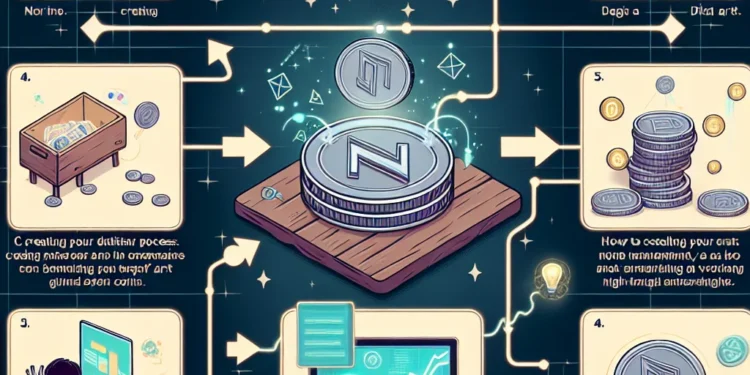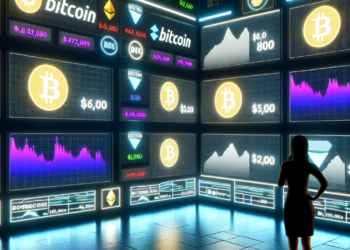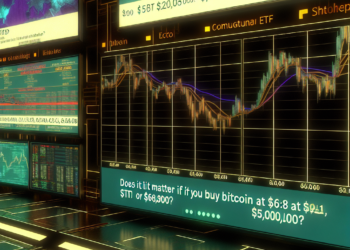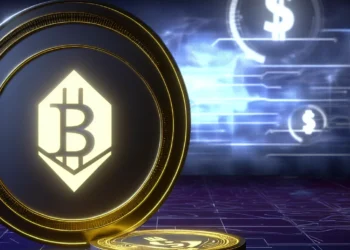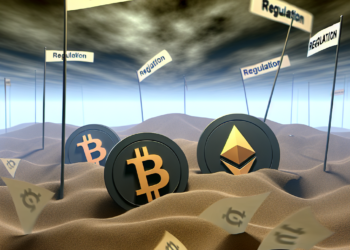Hey there, curious creator! Let’s chat about a hot topic in the digital world – NFTs. If you’re new to the scene, NFT stands for non-fungible token. But wait, don’t let the jargon scare you off. Think of it like this – NFTs are digital assets that represent ownership of a unique item or piece of content, like art, music, videos, and even tweets. Pretty cool, right?
So why the buzz around NFTs? Well, unlike physical goods, NFTs are stored on the blockchain, making them secure, transparent, and tamper-proof. Plus, they have the potential to revolutionize how creators monetize their work and connect with their fans. It’s an exciting time to be part of the NFT revolution!
Now, you might be wondering, “How can I get in on the NFT action?” Don’t worry, I’ve got your back. In this guide, we’ll walk through the steps of creating, selling, and managing your very own NFT. By the end of this journey, you’ll be a bonafide NFT pro!
Are you ready to dip your toes into the world of NFTs? Creating your very first Non-Fungible Token can be an exciting and rewarding experience. Let’s walk through the process together, step by step, so you can start minting your own digital masterpiece!
Creating Your First NFT
Before we dive into the creation process, let’s make sure we’re on the same page about what an NFT actually is. NFT stands for Non-Fungible Token, which means that it’s a unique digital asset that cannot be replicated or exchanged for something else like cryptocurrencies. Each NFT is stored on a blockchain, making it secure and tamper-proof.
Now, to create your first NFT, you’ll need to decide what you want to tokenize. It could be a piece of artwork, a digital collectible, a music file, a tweet, or even a virtual real estate property. Once you’ve chosen your digital asset, you’ll need to select a platform to mint your NFT. Some popular platforms include OpenSea, Rarible, and Mintable.
Once you’ve selected a platform, you’ll need to follow the specific instructions on how to mint your NFT. This typically involves uploading your digital file, adding a title and description, and setting any additional properties such as royalties or unlockable content. Make sure to double-check all the details before finalizing the minting process.
After you’ve successfully minted your NFT, you’ll receive a unique token ID that represents your digital asset on the blockchain. Congratulations, you’ve officially joined the world of NFTs!
Remember, the key to creating a successful NFT is to make it unique, valuable, and marketable. Put your creativity and passion into your digital assets, and the possibilities are endless.
Now that you’ve minted your first NFT, the next step is to choose the right marketplace to showcase and sell your digital masterpiece. Stay tuned for our next guide on how to select the perfect NFT marketplace for your creations!
Creating Your First NFT
So, you’ve decided to dip your toes into the exciting world of NFTs. Congratulations! Now comes the fun part – creating your very first NFT. But where do you start? Don’t worry, I’ve got you covered.
1. Do Your Research:
Before you dive into creating your NFT, take some time to research different NFT marketplaces. Each marketplace has its own set of rules, fees, and audience. Make sure to choose one that aligns with your goals and target audience.
2. Choose the Right Platform:
Once you’ve done your research, it’s time to choose the right platform to mint your NFT. Some popular platforms include OpenSea, Rarible, and Mintable. Each platform has its own unique features, so make sure to explore them and see which one suits your needs best.
3. Create Your Artwork:
Now comes the creative part – creating your artwork for your NFT. Whether you’re a digital artist, photographer, musician, or writer, the possibilities are endless. Remember, your NFT is a unique digital asset, so make sure your artwork is original and stands out.
4. Mint Your NFT:
After you’ve created your artwork, it’s time to mint your NFT. Minting simply means creating a digital certificate of ownership for your artwork on the blockchain. This process usually involves uploading your artwork, adding metadata (such as title, description, and royalties), and paying a minting fee.
5. Set a Price:
Once your NFT is minted, it’s time to set a price for it. When setting a price, consider factors such as the quality of your artwork, your reputation as an artist, and market trends. Don’t be afraid to experiment with pricing to see what works best for you.
6. List Your NFT:
After setting a price, it’s time to list your NFT on the marketplace. Make sure to write a compelling description that highlights the uniqueness of your artwork and engages potential buyers. Adding high-quality images or videos can also help attract more attention to your NFT.
7. Promote Your NFT:
Now that your NFT is live on the marketplace, it’s time to promote it. Share it on social media, reach out to your network, and engage with the NFT community. The more exposure your NFT gets, the more likely it is to sell.
8. Engage with Your Buyers:
Once your NFT is sold, make sure to engage with your buyers. Thank them for their support, answer any questions they may have, and keep them updated on any future NFT drops or events. Building relationships with your buyers can lead to repeat sales and word-of-mouth referrals.
Creating your first NFT can be a thrilling experience. Follow these steps, stay creative, and most importantly, have fun with it. Who knows, your first NFT could be the start of an exciting journey into the world of digital art and collectibles. Good luck!
Setting a Price for Your NFT
So, you’ve created your first NFT – congratulations! Now comes the exciting part of setting a price for your digital masterpiece. Pricing your NFT can be a bit of a challenge, but with the right approach, you can maximize your earning potential and attract interested buyers. Here are some tips to help you navigate this process:
1. **Understand the Value of Your NFT**: Before you set a price, take some time to evaluate the value of your NFT. Consider factors such as the uniqueness of your artwork, the time and effort you put into creating it, and the demand for similar pieces in the market. Remember, your NFT is more than just a digital file – it’s a piece of art that holds sentimental and creative value.
2. **Research Similar NFTs**: Look at other NFTs in your niche or style to get an idea of how they are priced. This will give you a good sense of the market trends and help you determine a competitive price for your own NFT. Keep in mind that prices can vary widely depending on factors like the artist’s reputation, the rarity of the artwork, and the platform it’s being sold on.
3. **Consider Your Target Audience**: Think about who your target audience is and what they are willing to pay for your NFT. Are you targeting art collectors, crypto enthusiasts, or fans of your work? Understanding your audience will help you tailor your pricing strategy to appeal to potential buyers and increase your chances of making a sale.
4. **Factor in Fees and Costs**: When setting a price for your NFT, don’t forget to account for any fees or costs associated with selling on a marketplace. Platforms like OpenSea and Rarible charge transaction fees, so make sure to factor these expenses into your pricing strategy to ensure you’re not losing money on each sale.
5. **Be Flexible**: Pricing your NFT is not set in stone – you can always adjust the price based on market demand and feedback from potential buyers. Consider starting with a slightly lower price to attract attention and then gradually increase it as interest grows. Remember, the goal is to find the right balance between making a profit and attracting buyers.
6. **Promote Your NFT**: Marketing plays a crucial role in determining the value of your NFT. Use social media, online forums, and other channels to promote your artwork and generate buzz around it. The more exposure your NFT gets, the more likely it is to attract interested buyers willing to pay a premium for your creation.
By following these tips and taking a thoughtful approach to pricing your NFT, you can increase your chances of success in the competitive world of digital art. Remember, pricing is not just about making money – it’s about recognizing the value of your creativity and connecting with an audience that appreciates your work. Good luck!
Setting a Price for Your NFT
- Understand the Value of Your NFT
- Research Similar NFTs
- Consider Your Target Audience
- Factor in Fees and Costs
- Be Flexible
- Promote Your NFT
Marketing Your NFT
So, you’ve created your first NFT – congratulations! Now comes the exciting part: marketing your NFT to attract potential buyers and collectors. Think of marketing as your opportunity to showcase your unique creation and build buzz around it. Here are some tips to help you effectively market your NFT:
1. Build Your Online Presence
Before you can market your NFT, you need to establish a strong online presence. Create social media accounts on platforms like Twitter, Instagram, and Discord where you can share updates about your NFT and engage with your audience. A website or blog can also be a great way to showcase your work and attract potential buyers.
2. Tell Your Story
Every NFT has a story behind it – whether it’s the inspiration behind the artwork or the process of creating it. Share your story with your audience to create a personal connection and make your NFT more appealing. People love to know the story behind the art they’re buying, so don’t be afraid to share your journey.
3. Collaborate with Influencers
Influencer marketing can be a powerful tool for promoting your NFT. Reach out to influencers in the NFT space or in the art world who align with your brand and ask them to promote your NFT to their followers. Their endorsement can help you reach a wider audience and attract more attention to your work.
4. Engage with Your Audience
Engagement is key to building a loyal following and attracting potential buyers. Respond to comments, messages, and inquiries from your audience promptly and thoughtfully. Hosting Q&A sessions, giveaways, or virtual events can also help you connect with your audience and generate interest in your NFT.
5. Create a Marketing Plan
To effectively market your NFT, you need a solid marketing plan. Define your target audience, set clear goals, and outline the strategies and tactics you’ll use to promote your NFT. Whether it’s running ads, partnering with other creators, or participating in NFT communities, having a plan in place will help you stay organized and focused on reaching your marketing objectives.
6. Leverage NFT Marketplaces
Take advantage of NFT marketplaces like OpenSea, Rarible, or Foundation to showcase and sell your NFT. These platforms have built-in audiences of collectors and buyers who are actively looking for new and unique creations. By listing your NFT on these marketplaces, you can increase its visibility and reach a larger pool of potential buyers.
Remember, marketing your NFT is an ongoing process that requires creativity, consistency, and persistence. Stay engaged with your audience, experiment with different marketing strategies, and don’t be afraid to think outside the box. With the right marketing efforts, you can attract the attention your NFT deserves and find the perfect buyer who will appreciate your artistry. Good luck!
Creating and selling your first NFT can be an exciting and rewarding experience. Once you have your unique digital asset ready to go, it’s time to focus on selling it to interested buyers. Here are some key steps to keep in mind when it comes to selling your NFT:
Selling Your NFT
Once your NFT is created and listed on a marketplace, the next step is to actively promote and sell it. Here are some key tips to help you successfully sell your NFT:
1. **Engage with Your Audience**: Building a community around your NFT can help generate interest and attract potential buyers. Engage with your audience on social media platforms, create behind-the-scenes content, and offer sneak peeks to generate excitement.
2. **Leverage Influencers**: Collaborating with influencers in the NFT space can help increase visibility and reach a larger audience. Partnering with influencers who align with your brand can help drive interest and sales.
3. **Utilize Marketing Strategies**: Consider running targeted ads, creating a website or landing page for your NFT, and exploring other marketing strategies to reach potential buyers. A well-thought-out marketing plan can help attract attention and drive sales.
4. **Host Virtual Events**: Hosting virtual events such as live auctions, Q&A sessions, or virtual galleries can create a sense of exclusivity and drive interest in your NFT. Engaging with your audience in real-time can help build a connection and encourage sales.
5. **Offer Limited Editions or Bundles**: Creating limited editions or bundles of your NFT can add value and exclusivity to your digital asset. Limited editions can create a sense of urgency and drive sales, while bundles can offer added value to buyers.
6. **Provide Transparency and Customer Service**: Building trust with potential buyers is crucial when selling your NFT. Be transparent about the creation process, ownership rights, and any other relevant information. Offering excellent customer service can help build a positive reputation and encourage repeat sales.
7. **Consider Secondary Markets**: Once your NFT is sold, keep in mind that buyers may choose to resell it on secondary markets. Stay informed about the secondary market for your NFT and consider how this may impact future sales and pricing strategies.
Selling your NFT requires a combination of marketing, engagement, and strategic planning. By following these tips and staying engaged with your audience, you can increase the chances of successfully selling your digital asset and growing your presence in the NFT space.
Creating and selling your first NFT can be an exciting and rewarding experience. Once you have your unique digital asset ready to go, it’s time to focus on selling it to interested buyers. Here are some key steps to keep in mind when it comes to selling your NFT:
Selling Your NFT
- Engage with Your Audience: Building a community around your NFT can help generate interest and attract potential buyers. Engage with your audience on social media platforms, create behind-the-scenes content, and offer sneak peeks to generate excitement.
- Leverage Influencers: Collaborating with influencers in the NFT space can help increase visibility and reach a larger audience. Partnering with influencers who align with your brand can help drive interest and sales.
- Utilize Marketing Strategies: Consider running targeted ads, creating a website or landing page for your NFT, and exploring other marketing strategies to reach potential buyers. A well-thought-out marketing plan can help attract attention and drive sales.
- Host Virtual Events: Hosting virtual events such as live auctions, Q&A sessions, or virtual galleries can create a sense of exclusivity and drive interest in your NFT. Engaging with your audience in real-time can help build a connection and encourage sales.
- Offer Limited Editions or Bundles: Creating limited editions or bundles of your NFT can add value and exclusivity to your digital asset. Limited editions can create a sense of urgency and drive sales, while bundles can offer added value to buyers.
- Provide Transparency and Customer Service: Building trust with potential buyers is crucial when selling your NFT. Be transparent about the creation process, ownership rights, and any other relevant information. Offering excellent customer service can help build a positive reputation and encourage repeat sales.
- Consider Secondary Markets: Once your NFT is sold, keep in mind that buyers may choose to resell it on secondary markets. Stay informed about the secondary market for your NFT and consider how this may impact future sales and pricing strategies.
Selling your NFT requires a combination of marketing, engagement, and strategic planning. By following these tips and staying engaged with your audience, you can increase the chances of successfully selling your digital asset and growing your presence in the NFT space.
Managing and Delivering Your NFTs
So, you’ve created your first NFT, chosen the right marketplace, set a price, and marketed your piece to potential buyers. Now, it’s time to focus on managing and delivering your NFT to the lucky collector who purchases it. This step is crucial to ensure a smooth and successful transaction, so let’s dive in!
1. Secure Storage
Once your NFT is sold, it’s essential to securely store the digital asset to prevent any unauthorized access or loss. Consider using a secure digital wallet or storage solution to keep your NFT safe and sound until it’s ready to be transferred to the buyer.
2. Verification and Transfer
Before transferring the NFT to the buyer, make sure to verify the authenticity of the transaction. Confirm the payment has been received, and double-check the buyer’s wallet address to avoid any mistakes in transferring the NFT. Once everything is verified, go ahead and transfer the NFT to its new owner.
3. Communication with the Buyer
It’s always a good idea to maintain open communication with the buyer throughout the process. Update them on the status of the transaction, provide any necessary information or documentation, and address any questions or concerns they may have. A positive buyer experience can lead to repeat business and enhance your reputation as an NFT creator.
4. Delivery Confirmation
After transferring the NFT to the buyer, it’s essential to obtain confirmation of delivery. This can be done through the blockchain network, which records the transaction and ownership transfer. Once the buyer confirms receipt of the NFT, you can consider the transaction complete.
5. Follow-Up and Feedback
After the transaction is complete, don’t forget to follow up with the buyer to ensure they are satisfied with their purchase. Ask for feedback on their experience and any suggestions for improvement. Positive feedback can help build trust with future buyers and enhance your credibility as an NFT creator.
Managing and delivering your NFTs may seem like a daunting task, but with proper planning and organization, it can be a smooth and rewarding process. By following these steps and staying proactive in your communication with buyers, you can ensure a positive experience for both parties and set the stage for future success in the NFT marketplace.

